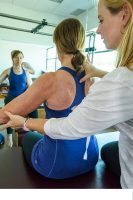Is Pilates Just a Fad?
In an industry where the sands shift quickly from one fitness trend to the next, it has been interesting to watch the rise and fall of various fitness methodologies, and in particular the trajectory of the Pilates method. Some might say Pilates is just a fad.
In the late 1990’s and early 2000, Pilates seemed to be THE thing. Spring forward to 2010, and Pilates dropped off the Academy of Sports Medicine & Science (ACSM) List of Top 10 Fitness Trends. In 2021, Pilates is popular, but it competes with other modalities that some feel are more exciting and up-to-date. Is Pilates just another fitness fad, destined to disappear like jazzercise and tae-bo? Is there a relevance for the Pilates method, when the very notion of core strength training has been scientifically challenged? Can the Pilates method contribute anything to a world entranced with extreme sports and high intensity interval training (HIIT)?
No, Pilates is not a fad. Yes, it remains relevant today. And Pilates absolutely has a contribution to make. To understand the value of Pilates within the sphere of fitness, conditioning & rehabilitative movement, one has to look no further than the six basic principles of the method. Beyond beautiful bodies doing wild things on cool looking equipment, beyond a particular focus on core strength, beyond the stunning videos people share on Instagram and Facebook; the fundamentals of Pilates are important components in creating the quality of movement that promotes freedom and flow, and a strong, agile body. For people looking beyond the latest fads, who have a desire to move well and connect deeply to their bodies in motion, the Pilates method, taught and practiced well, will always be in fashion.
Here’s a quick view of the Six Basic Principles of the Pilates as I learned them almost 30 years ago, along with my thoughts how they have evolved in my practice over the years.
1. Concentration:
 THEN: Concentration and focus are required to learn about muscles, bones, breathing and the coordination of it all. Attention and sensory awareness should be developed to learn to recognize and understand information coming in from the body. With practice, you can evaluate that information and react quickly (and eventually automatically).
THEN: Concentration and focus are required to learn about muscles, bones, breathing and the coordination of it all. Attention and sensory awareness should be developed to learn to recognize and understand information coming in from the body. With practice, you can evaluate that information and react quickly (and eventually automatically).
NOW: We live in a world that seems programmed to take us out of contact with our own bodies: the tech, the vehicles, the pace and the expectation that we do it all. Typically, our bodies carry our heads to the gym, do some stuff and then carry us back to our crazy disconnected existence. A good Pilates program demands an internal focus; asking us to pay attention to the state of our bodies, our breath, and the way we move. A happy bi-product is the fact that this internal focus tends to help to balance our nervous systems. In a balanced state, our restorative functions can come back online; making it easier to relieve stress in our systems. We learn to recognize and process sensory information coming to the brain from the body, instead of having a constant one way directive going from brain to body.
2. Control:
THEN: To develop the relationship between the physical self and the brain for control and power.
NOW: Where there are movement challenges or deficits, motor control training can provide better access to the support required to move well. In this sense, an exercise is never just “an exercise” for an experienced movement instructor. Great Pilates instructors look to see where movement is being executed well, and where more support is required. And then they help us to find the necessary control to create that support. Maybe it is finding better access to your abdominal muscles. It could just as easily be about releasing a foot, or supporting shoulder blade in a different way. The more we hone the communication between body and mind, the more we have the power, in our own bodies, to make change. With good motor control, we learn that we are responsible for own bodies and movement choices. I think there is enormous power in that.
3. Centering:
THEN: To learn to stabilize through your centre, making it easier to stabilize everywhere else. A stable centre is crucial for support of the spine and central nervous system. Back in the days when I was first training, this was mostly about building the “powerhouse” and strengthening the “core,” even though there was little consensus among exercise professionals about exactly what the core actually was. A great deal of emphasis was placed on accessing and engaging the deep abdominal muscles in particular.
NOW: Modern research has shown that the notion of “core stability” is a little different than we thought in the 1990’s. (See: The Myth of Core Stability and the The Core Stability Myth.) Instead, we’ve come to understand that adequate tone, motor control and movement patterning are much more important in creating an integrated system capable of managing and adapting to a wide range of load demands. You can crunch your way to fame and fortune creating a fabulous set of abdominal muscles – but if integrated function with other systems is lacking – those fabulous abs may not be much more than window dressing in terms of the structural sustainability of your overall movement.
4. Precision:
THEN: Practice does not equal perfect. Perfect practice equals perfect. In a high quality Pilates class setting, there is consistent guidance to ensure quality movement for best results.
NOW: If we understand that much of the work in a Pilates program is about training great movement patterns, then we must make sure those movement patterns are clean and precise. Simply bashing off a bunch of reps with no mindful connection to how me move is counterproductive. In terms of patterning, a few beautifully executed repetitions will always trump a whole bunch of sloppy, mindless ones. Strength gained by compensation will someday take a toll on the body. When good control and form start to suffer – function will eventually suffer too. Pilates, as I learned it, and as I practice and teach it now, is about working smart.
5. Flowing Movement
THEN: The whole Pilates system is about movement, not about strength for it’s own sake. Humans learn through movement, not by being still, or by working individual muscles in isolation. The best way to create strength is through movement, gradually increasing the load demand and range of motion required.
NOW: The concept of flowing motion hasn’t changed much, in my eyes. When a movement is uncoordinated, it’s a clear indication that control is lacking. If one kind of movement doesn’t flow well – try another pathway. It’s about finding where the body can find ease in motion, and building up from there. When movement flows, it’s possible to work really hard without feeling struggle. Pilates creates an agile strength that is valuable no matter how you like to move.
6. Breathing
THEN: To inspire movement through the use of proper breathing techniques.
NOW: In a world that sits way too much, breathing pattern disorders are rampant. As an instructor, my interest is in finding breath patterns that will support the structure and the movement of the person with whom I’m working. Breath plays a huge role in virtually every single system in the body. Breathing patterns can have a huge impact in terms of energy and nervous system balance as well. It only makes sense for us to learn how to breathe in a way that supports our systems well.
Desk jockeys take note, “exercise” should not be the only way we get movement in our day to day lives. I see the effects of that in my practice every day. In my opinion, exercise programs are a supportive complement to our daily lives. Do active things whenever you get the chance. Pilates will you get started, but a variety of different movement serves you best!
I believe that Pilates offers an amazing array of possibilities for creating structurally sustainable movement over the long term. It’s a fabulous complement to whatever physical activities you like to engage in. Move, enjoy living the life of your body. When you want support for that, a Pilates program can help.
Are you curious about what a Pilates program might do for you? At Moving Spirit, we create personalized, purpose-built programs so clients can improve their mobility, stability, stamina and strength. Our goal is to develop an intentional training practice, so each client learns how their body works best. We’re here to help people reach their movement goals in a way that respects individual needs, and guide them toward a deepening relationship with their bodies in motion, all while improving their overall fitness and health.
Click here to learn more about our programs and book an Introductory Private Training Package today.
About Susannah Steers
 Susannah is a Pilates and Integrated Movement Specialist, and owner of Moving Spirit. Through movement teaching, speaking, and facilitating workshops, she supports people in creating movement practices that promote fitness from the inside out. She loves building community, and participating in multi-disciplinary collaborations.
Susannah is a Pilates and Integrated Movement Specialist, and owner of Moving Spirit. Through movement teaching, speaking, and facilitating workshops, she supports people in creating movement practices that promote fitness from the inside out. She loves building community, and participating in multi-disciplinary collaborations.
Along with her friend and colleague Gillian McCormick, Susannah co-hosts The Small Conversations for a Better World podcast – an interview based podcast dedicated to promoting the kind of conversations about health that can spark positive change in individuals, families, communities and across the globe.
If you liked this article, you might like these ones too!
How Often Do I Need to Do Pilates to Get Results?
Movement Practice or Exercise… Or Both?
